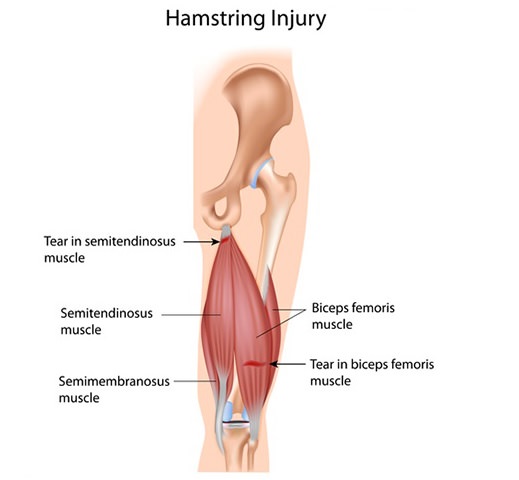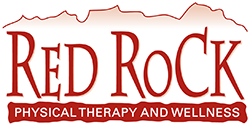What is a Hamstring Strain?
A hamstring strain is a common pain that strikes many athletes. At the back of your thigh, there are three muscles that run along from your buttock to the back of your knees. A hamstring strain is the injury or tear of one or more of these muscles. It varies from a mild hamstring pull to a tear. This strain usually occurs at the base of the buttocks or in the middle part of the back thigh, where the tendon joins the muscle.
The three muscles which run down the back of your leg, from your thigh to your knee, are the biceps femoris, semitendinosus, and semimembranosus. These help you bend your knee and extend your hip. As a group, they are known as the hamstring. If these begin to stretch too far or tear, a hamstring strain, or pulled hamstring can occur.
Hamstring strains can be mild, with little pain and a short recovery time. Or, they can be severe and need surgery and crutches for weeks.
Some of our McHenry area clients have hamstring strain symptoms way before the pain completely puts them down or forces them to come to our McHenry physical therapy office. For this reason, it is important to ensure that you are well informed about the symptoms that characterize this very common strain.
Jump to A Section

What are common symptoms of Hamstring strain?
There are different levels of strain, and for this reason, it is important to see a McHenry physical therapist or doctor for examination. However, some of the most common hamstring strain symptoms include:
- A sudden feeling of sharp or popping pain at the back of the leg after some exercises. This often leads to tenderness of the muscle in the affected leg, resulting in a cramp.
- When the hamstring strain is very severe, you may be unable to stand or walk; and there will be visible swelling and bruising.
- There may also be discoloration at the back of the affected leg and it will feel tight, making it painful and unbearable to walk.
- Tenderness in the back of the thigh
- Weakness in your leg that lasts for a long time after the injury
You may be wondering, “What does a hamstring cramp feel like?” A hamstring cramp is a sudden burst of pain, often severe, which stops after a few seconds to a minute. A bulge in the cramped muscle will feel hard and tense. Tenderness and swelling may last for several days.
Nonetheless, the best way to understand the symptoms is by understanding the hamstring strain levels of severity. With this kind of information, it is easier to know which step to take towards getting the appropriate medical attention.
Hamstring strain symptoms according to level of severity
- Level one – The first level is also known as grade 1 hamstring strain is mild compared to others. With this you may feel tightness in the back thigh, but it will not affect your mobility. However, your full speed will be greatly affected due to the discomfort. There may also be a little swelling in the affected leg.
- Level two – At this second grade hamstring strain, you may find yourself limping and unable to walk easily. You will also feel sharp pain with every movement you make. And when you try to bend the knee , you will feel a lot of pain on the hamstring muscle.
- Level three – A grade 3 hamstring strain is very serious and warrants immediate and proper attention. This may be characterized by tear in part of the muscle or all of it. It comes with severe pain, paralyzing walking ability completely. The muscle becomes weak and there is visible swelling and bruising within 24hours.

What Causes a Hamstring Strain?
A hamstring strain generally occurs as a result of muscle overload, such as when you are running and your leg is fully stretched out just before your foot strikes the ground. When your foot strikes the ground and all your weight is on it, the muscles can get stretched too far and then may start to tear.
People who take part in certain activities that involve sprinting or jumping (like track and field, soccer, football, lacrosse, basketball, and dance) are more at risk of getting hamstring strains. These kinds of injuries are also more common in teens who are going through growth spurts. That’s because the leg bones may grow faster than a person’s muscles, pulling the muscles tight and leaving them more susceptible to getting stretched too far.
Some of the more common things that can contribute to a hamstring strain include:
- Not warming up properly before exercising. Tight muscles are much more likely to strain than muscles that are kept strong and flexible.
- Being out of shape or overdoing it. Weak muscles are less able to handle the stress of exercise, and muscles that are tired lose some of their ability to absorb energy, making them more likely to get injured.
- An imbalance in the size of your leg muscles. The quadriceps, the muscles at the front of your legs, is often larger and more powerful than your hamstring muscles. When you do an activity that involves running, the hamstring muscles can get tired more quickly than the quadriceps, putting them at greater risk of a strain.
- Poor technique. If you don’t have a good running technique, it can increase the stress on your hamstring muscles.
- Returning to activities too quickly after an injury. Hamstring strains need plenty of time and rest to heal completely. Trying to come back from a strain too soon will make you more likely to injure your hamstring again.
What questions might a healthcare provider help to diagnose a hamstring injury?
It’s helpful to be prepared to answer questions your healthcare provider may ask. Possible questions include:
- What symptoms are you experiencing?
- Are you in pain?
- Where is the pain located?
- When did the injury occur?
- What were you doing when you were injured?
- What medications do you take?
When should I see my healthcare provider?
Your hamstring injury might just need to be treated at home. However, you should see your healthcare provider if:
- The injury is severe.
- Your symptoms worsen.
- Your injury isn’t healing.
- You have sudden tingling or numbness in your leg.
- The swelling suddenly gets worse.
Though you can treat mild hamstring strain or a hamstring pull, it is important to see a McHenry physical therapy clinic if the pain becomes severe. To find out if you should rest or try to push through, try to walk more than four steps; if you cannot go past that, then you should see your local physical therapist. Likewise, if your pain persists or limits you from running, walking, or playing your favorite sport after a few weeks you should also seek expert help and advice.
Our McHenry Physical Therapy Office
Red Rock Physical Therapy and Wellness is conveniently located in McHenry one and a half miles west of Northern Illinois Medical Center (Centegra/Northwestern) on the corner of Bull Valley and Crystal Lake Roads in the commercial building behind the BP gas station.
Red Rock Physical Therapy and Wellness
5435 Bull Valley Road
Suite 110
McHenry, IL 60050
815-451-4502
Hours:
Mon – Thurs: 8am – 6pm
Fri: 8am – 3pm
Sat – Sun: Closed


Contact Our Experienced McHenry Physical Therapists Near You
If you are looking for a highly rated McHenry physical therapist near you, contact our office at 815-451-4502 to speak with one of our local physical therapists to help you live pain free.
McHenry Physical Therapy Clinic Review
Red Rock Physical Therapy is a gem tucked away in McHenry. The staff is knowledgeable and friendly. They are willing to work with your schedule to get you in to receive care. They are concerned with your well being and safety. I recommend them to anyone needing physical therapy.
Rating: 5/5 ⭐⭐⭐⭐⭐
Shawn Smosna, April 4, 2020
Read more of our client reviews on our Google profile!

